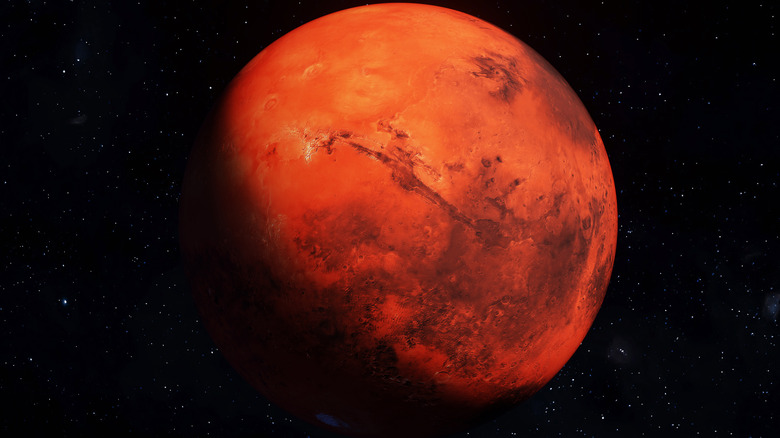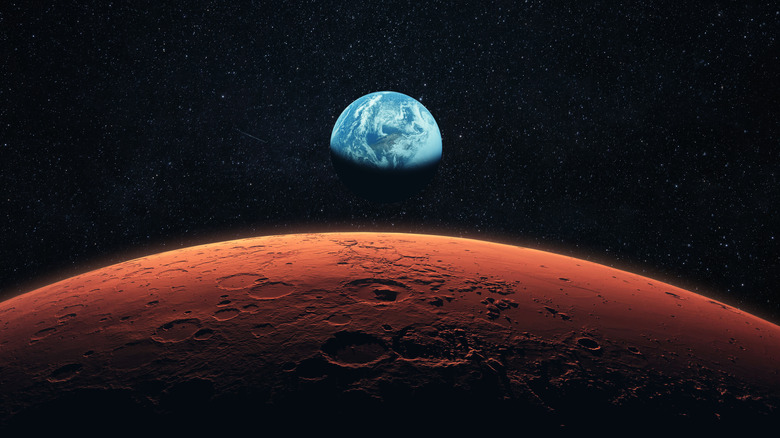What Winter On Mars Looks Like
The concept of the winter wonderland is quite a cliché. The name of the season alone often evokes images of snow, icicles, general chilly temperatures, and roaring fireplaces. The saccharine image of such things surely adorns millions of holiday cards every year.
Naturally, though, this isn't the reality for so many winter holidays celebrants around the world. In the Southern Hemisphere, the holidays take place in the summer. A chilly, snowy Christmas in the United Kingdom and a bright, sunny one in Australia may seem worlds apart, but they both embrace the spirit of joy and togetherness that the holidays of the period typically embody.
Whether your winter falls around the end of the year or the opposite side of the calendar, though, it tends to be accompanied by a dramatic downturn in the temperature and weather conditions. As Metro reported on December 29, 2022, the United States was struck by a devastating winter storm deemed a "cyclone bomb," which had tragically resulted in over 70 deaths to date.
Our weather here on Earth is certainly incredibly volatile, but what of other planets? Winter on Mars, it seems, is rather similar in its way: potentially very dangerous indeed.
The chilly martian temperatures
Many of us are used to having to break out the overcoats and battle an irritating spate of the sniffles in the winter, but that's nothing. We'd even be glad of that person in the office who sneezed directly at us if the alternative is to contend with the temperatures on other planets.
Universe Today reports that Neptune has the lowest average temperature of the planets in the solar system (discounting Pluto), reaching minus 360 degrees Fahrenheit (minus 218 degrees Celsius). However, further towards its bizarre gassy heart, it can be as hot as 12,632 degrees Fahrenheit (7,000 degrees Celsius). This is because atmospheric pressures are so very intense, and extreme temperatures define the planets as a whole.
Mars, being the fourth-closest planet to the sun, isn't this bone-chillingly cold. Per Space.com, the martian temperature falls as low as minus 200 degrees Fahrenheit (minus 128 degrees Celsius). This is outrageously cold from an earthling's perspective, but not so much from a universe-wide one. It seems that Mars sees beautiful snow during its winter, too.
NASA's Jet Propulsion Laboratory at California Institute of Technology reports that specialized NASA equipment has been able to provide a tantalizing glimpse of what a martian winter looks like. Not a direct look, sadly, as snow falls only under the cover of clouds and at the poles, when it's coldest and darkest and even remote-controlled explorers couldn't withstand the frigid temperatures. Images can't be captured from above, either, because of those pesky clouds.
A winter wonderland
However, NASA's Mars Climate Sounder, wielded by the Mars Reconnaissance Orbiter, peeled back the curtain on this mystery somewhat. The MCS uses infrared imaging, across nine channels, to detect the heat, dust, temperature, and other variables on the planet, alternately studying cross-sections on the planet's horizon from orbit. It has been able to create a picture of Mars' climate through the course of the planet's day.
Scientists have been able to detect snowfall on Mars. NASA's Jet Propulsion Laboratory (JPL) at California Institute of Technology explains that snow formed of carbon dioxide touches the ground, as it's too cold for the frozen water to remain. We know this frozen carbon dioxide as dry ice. The snowfall is quite extensive in flatter areas of Mars' poles, but it doesn't seem to reach any further. CNN adds that Mars' snow and ice has been seen to melt away into remarkable-looking gassy "sculptures," and that frosts can form across the planet. It would be truly dazzling to explore, though the sheets of resultant ice would surely be lethal.
We know that this carbon dioxide snow does fall on the Red Planet, and we also know that it would be quite delicate and beautiful to behold. Per NASA's JPL, Mars scientist Sylvain Piqueux explained, "Because carbon dioxide ice has a symmetry of four, we know dry-ice snowflakes would be cube-shaped ... these snowflakes would be smaller than the width of a human hair."


